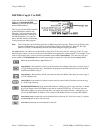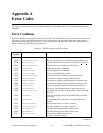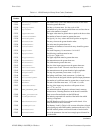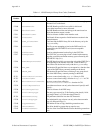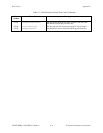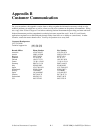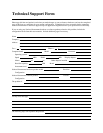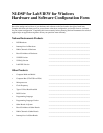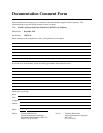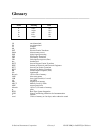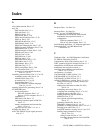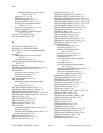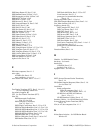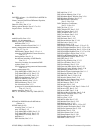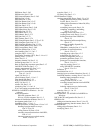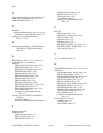Index
NI-DSP SRM for LabVIEW for Windows Index-4 © National Instruments Corporation
L
LabVIEW software. See NI-DSP for LabVIEW for
Windows.
Linear Constant Coefficient Difference Equation,
Part 3: 1-5
linker file (ifile), Part 4: 2-4
linking custom libraries, Part 4: 2-7 to 2-8
lowpass filters. See filter VIs.
M
makelib.bat file, Part 4: 2-8
manual. See documentation.
Memory Look Up Table (MLUT)
definition, Part 2: 1-3
number of entries allowed, Part 2: 1-3
memory management and data transfer,
Part 2: 1-2 to 1-4
DSP Handle Clusters, Part 2: 1-2 to 1-4
examples of DSP Handle Cluster allocation,
Part 2: 1-4
freeing buffers, Part 2: 1-4
hexadecimal encoding of DSP Handle,
Part 2: 1-3
lower-level routines for customized DSP
routines, Part 4: 2-3
VIs for memory management and data transfer,
Part 2: 1-2
memory management VIs
Copy Mem(DSP to DSP), Part 3: 2-1
Copy Mem(DSP to LV), Part 3: 2-2
Copy Mem(LV to DSP), Part 3: 2-3
DSP Allocate Memory, Part 3: 2-6
DSP Free Memory, Part 3: 2-34
DSP Index Memory, Part 3: 2-43
DSP Init Memory, Part 3: 2-44
list of functions, Part 3: 1-2
prototypes for customizable functions,
Part 4: 3-2 to 3-3
memory map files, Part 4: 2-7
MLUT. See Memory Look Up Table (MLUT).
N
NI-DAQ for DOS/Windows/LabWindows
software, xv
NI-DSP Analysis VIs
accessing, Part 3: 1-3 to 1-4
array VIs, Part 3: 1-2
Copy Mem(DSP to DSP), Part 3: 2-1
Copy Mem(DSP to LV), Part 3: 2-2
Copy Mem(LV to DSP), Part 3: 2-3
definition, xi
DSP Absolute, Part 3: 2-4
DSP Add, Part 3: 2-5
DSP Allocate Memory, Part 3: 2-6
DSP Blackman Harris Window, Part 3: 2-8
DSP Blackman Window, Part 3: 2-7
DSP Butterworth Coefficients,
Part 3: 2-9 to 2-10
DSP Chebyshev Coefficients,
Part 3: 2-10 to 2-11
DSP Clip, Part 3: 2-11
DSP Complex FFT, Part 3: 2-12
DSP Convolution, Part 3: 2-13
DSP Correlation, Part 3: 2-14
DSP Cross Power, Part 3: 2-15
DSP Custom, Part 3: 2-16
DSP Decimate, Part 3: 2-17
DSP Deconvolution, Part 3: 2-18
DSP Derivative, Part 3: 2-19
DSP Divide, Part 3: 2-20
DSP Elliptic Coefficients, Part 3: 2-21 to 2-22
DSP Equi-Ripple BandPass, Part 3: 2-23 to 2-24
DSP Equi-Ripple BandStop, Part 3: 2-25 to 2-26
DSP Equi-Ripple HighPass, Part 3: 2-27 to 2-28
DSP Equi-Ripple LowPass, Part 3: 2-29
DSP Exact Blackman Window, Part 3: 2-30
DSP Exponential Window, Part 3: 2-31
DSP FHT, Part 3: 2-32
DSP Flat Top Window, Part 3: 2-33
DSP Force Window, Part 3: 2-34
DSP Free Memory, Part 3: 2-34
DSP Gaussian White Noise, Part 3: 2-35
DSP General Cosine Window, Part 3: 2-36
DSP Hamming Window, Part 3: 2-37
DSP Handle Cluster input/output, Part 2: 1-5
DSP Hanning Window, Part 3: 2-38
DSP IIR Filter, Part 3: 2-39 to 2-40
DSP Impulse Pattern, Part 3: 2-41
DSP Impulse Train Pattern, Part 3: 2-42
DSP Index Memory, Part 3: 2-43
DSP Init Memory, Part 3: 2-44
DSP Integral, Part 3: 2-45
DSP Inv Chebyshev Coeff, Part 3: 2-46 to 2-47
DSP Inverse FFT, Part 3: 2-47
DSP Inverse FHT, Part 3: 2-48
DSP Kaiser-Bessel Window, Part 3: 2-49
DSP Linear Evaluation, Part 3: 2-50
DSP Load, Part 3: 2-50
DSP Log, Part 3: 2-51
DSP Max & Min, Part 3: 2-52
DSP Median Filter, Part 3: 2-53
DSP Multiply, Part 3: 2-54
DSP Parks McClellan, Part 3: 2-55 to 2-57
DSP Polynomial Evaluation, Part 3: 2-58
DSP Power Spectrum, Part 3: 2-59
DSP Product, Part 3: 2-59
DSP Pulse Pattern, Part 3: 2-60
DSP Ramp Pattern, Part 3: 2-61
DSP Random Pattern, Part 3: 2-62
DSP ReFFT, Part 3: 2-63



